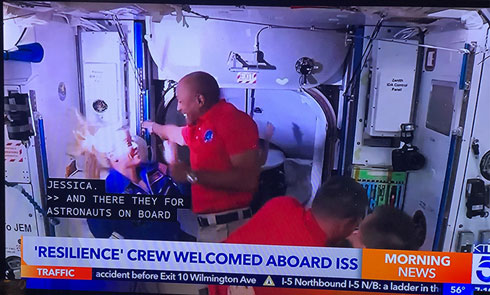Greetings from Palmia Observatory
Well we have been busy with online meetings and just about to complete our month long study of lunar measurements, but we were lucky enough to go outside and capture an image of the ISS passing overhead.
Luckily, we received a heads up email from OCA Tom, who pointed out the next opportunity to see the ISS passing overhead. It was going to be visible, in reflected light, for about two minutes, beginning at 6:21 pm. So, I elected to use a wide angle DSLR telephoto and I used Jupiter to focus the lens and then pointed the camera in the general direction covering the projected southwest to southeast passage. It worked as you can see and we captured the whole, just barely, 30 second image of the ISS track. The ISS was about as bright at Jupiter. Thanks for the heads up, Tom!
 |
| ISS overhead, past the trees, in this 30 second, 47mm DSLR image (Source: Palmia Observatory) |
Afterwards, other amateurs commented that they were able to also see the Dragon spacecraft "Resilience" following along behind the ISS. We were quite lucky to have the ISS pass overhead at the same time that the Dragon was chasing right behind. Wow, did I miss a chance to see that spacecraft too?
No, it turns out that when I expanded the image and adjusted the contrast more, the dim track of the Dragon showed up too. Check it out in the expanded image below. Also very luckily, the exposure started at just the right time. The ISS is moving across the sky, starting at the bottom right and moving toward the upper left part of the image. We also can see the Dragon track starting just below and to the right of the start of the ISS track. This distance can be used to estimate how many miles behind the Dragon was at that time.
 |
| The Dragon spacecraft track just barely visible next to and below ISS (Source: Palmia Observatory) |
Luckily, we were able to capture the entire track of the ISS over the 30 second exposure and the palm trees were just barely in the right location. I thought initially that the ISS would pass overhead above the trees, but it passed a little lower in the sky than I expected. Nonetheless, we can measure the pixel lengths of the tracks and the difference between the ISS and Dragon tracks.
The following table summarizes all of the original data and the estimated distances, in miles. We get pixel distances from the image using Photoshop. The miles values for the ISS are computed from known orbital parameters. The ISS is nominally 254 miles the Earth and orbits the Earth every 91 minutes. So from these values, we calculate the distance travelled by the ISS every minute is 291 miles. Now, let's assume the linear, flat pixel distances on the image are close enough to the nearly linear portion of the ISS circular orbit. So, when we convert the pixel differences to miles we find that the Dragon was probably about 5.6 miles behind the ISS and the difference between the two tracks was about one mile. Now the distance between the two tracks cannot be measured without some uncertainty because we are measuring between the two tracks but we don't know how much each track is separated in the third dimension.
 |
| Summary chart showing conversion of pixels to miles for ISS/Dragon (Source: Palmia Observatory) |
If you want to check out the next opportunity to view the ISS overhead, there are many available online tools to help find the next occurrence for your particular location, go to, for example: https://spotthestation.nasa.gov/sightings/index.cfm
| One tool that can predict good ISS viewing opportunities (Sourc: https://spotthestation.nasa.gov/sightings/index.cfm) |
So, while we follow the ISS from the ground, the Dragon spacecraft has managed to catch up and dock with the ISS. This flight to the ISS is a major success for NASA and SpaceX . The morning KTLA 5 TV news showed the joyous event in the screenshot below.
 |
| KTLA 5 TV shows Dragon 'Resilience' Crew Welcomed on board ISS (Source: Palmia Observatory) |
Until next time, here from our burrow, stay safe, as we recover more of our freedom,

No comments:
Post a Comment